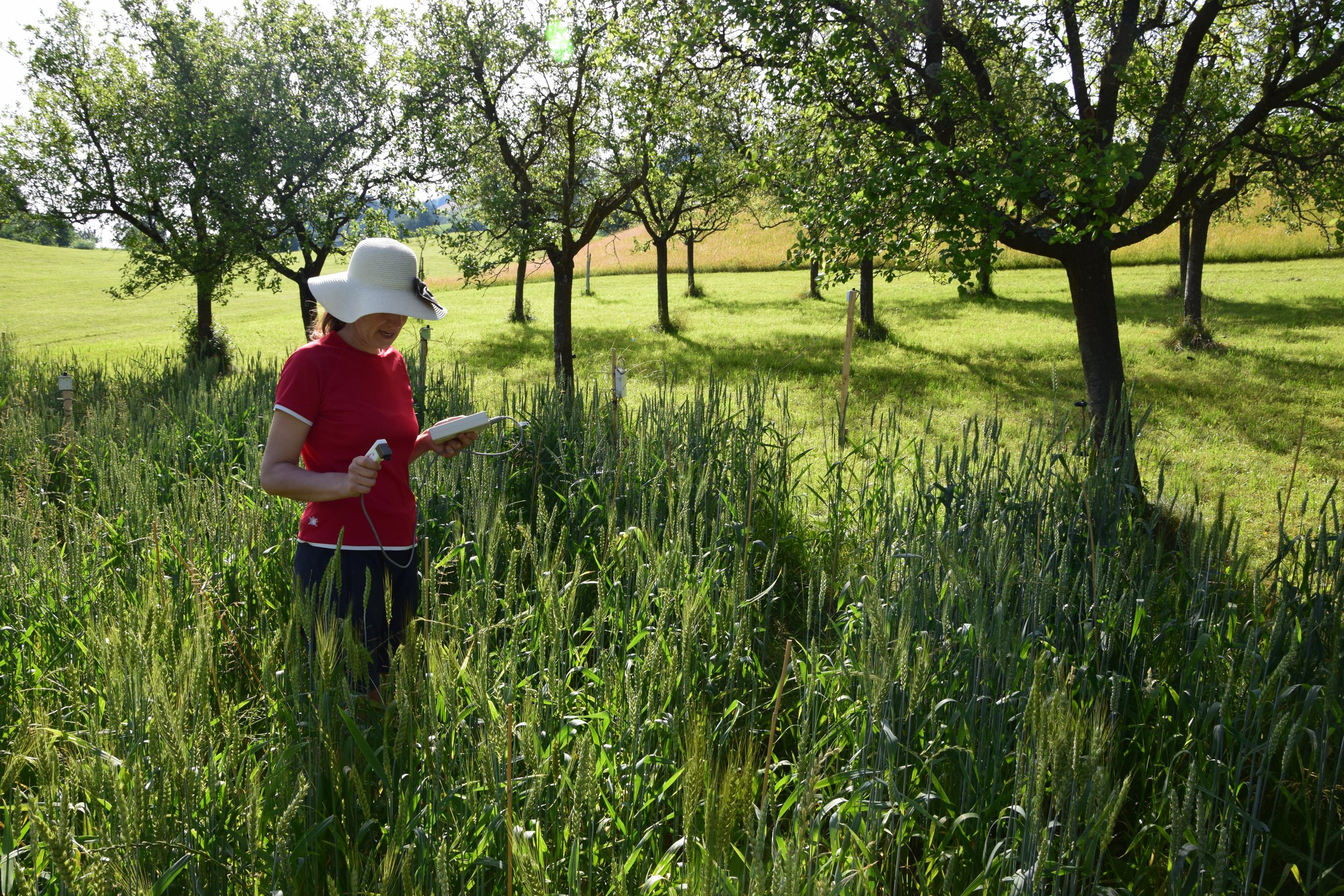The beauty of diversity – and its agro-ecological benefit
As you look over the field, the first thing that catches your eyes is the varying heights of the wheat plants. There are giants standing out and dwarfs somewhat hidden in-between. Then you notice different colours, shades of green and yellow. You detect ears (the grain-bearing tip parts of the stem of a cereal plant) with awns (bristle-like appendages) and without, long ones and short ones – awns, that is to say, and also ears. Everything varies to certain degrees in this wheat field. Because this is not a “normal” wheat field. It is something very special with a particular name: a composite cross population. A composite cross population (CCP) is a genetic pool of descendants from a multitude of varieties. Do you think it could perform better in a more natural, heterogeneous environment like in an agroforestry system?
First things first: What CCP are we talking about? In my trials, we use the “CC-2k” from Agroscope, initially constituted with the F1 generation of the diallel crosses of 20 European winter wheat varieties. In this setting, where each plant is a proper genotype, the population has the genetic plasticity to adapt autonomously to biotic and abiotic stresses. In our experiment, we use a sub-population that has evolved for 20 years in agricultural plots in Western Switzerland.
Genetic diversity and ecological benefit
This immense visible and intrinsic genetic diversity within the CC-2k wheat population is not only beautiful to view in the field. Genetic diversity – whether between varieties or, as in this particular case, within a population – is the basis for the ability to adapt. To adapt in terms of pathogens, management practices as well as climatic changes. No wonder that in recent years CCPs have been proposed as a way to create “modern landraces” [note: A landrace is a domesticated, locally and to its natural environment adapted, traditional variety] of wheat, barley and oats. Considering the huge genetic plasticity, it is conceivable that CCPs outperform pure varieties especially under low-input, organic and in general under marginal production conditions.
In my research project, I study the agronomic and ecological performances of CC2k in environmentally diverse microclimates of agroforestry systems. If you are not yet familiar with the old, but newly discovered agricultural practice: Agroforestry systems incorporate trees and shrubs on the same land area as agricultural crops or livestock. The practice of agroforestry can be considered a more sustainable compared to conventional agriculture while remaining economically productive. What is more, agroforestry systems are able to deliver a range of ecosystem services such as biodiversity conservation, soil fertility and erosion control. However, of course, growing trees and crops jointly also brings disadvantages: Light competition above-ground and water and nutrient competition below-ground have to be considered when planning and managing an agroforestry system. The tree-crop interactions, furthermore, depend not only on climate, but change rapidly in their intensity with increasing/decreasing distance between the tree row and the crop field, resulting in a heterogeneous environment.
Measuring stomatal conductance in the experimental winter wheat field in Feusisberg, Schwyz (picture: Christina Vaccaro).
Pioneer research with a CCP in two agroforestry systems in Switzerland
Back to the variegated wheat fields in Wollerau and Feusisberg in Canton Schwyz. I have been given the opportunity to conduct a comparison of a common winter wheat variety used in organic farming with the CC-2k at two agroforestry sites of two cooperative and open-minded farmers. Fabio Mascher from the wheat and soybean breeding group at Agroscope in Changins, Nyon, has provided the seeds of the CC-2k composite cross populations. When we first talked about their CC-2k, I was excited to be given some kilograms of this precious seeding material for our research project. But looking now at the living and thriving plants in an agroforestry field lined by two apple tree rows is another level. Particularly in the mornings and evenings, when everything human (the usual car traffic noises that is to say) is asleep, the “agro-ecological” vibe radiating around these fields simply gets to you. If you then look at the very beginning or at the end of a hard field work day over the fields, you know why you signed up for this hard endeavour.
Nine months have passed since sowing. So far, we have already observed differences in leaf chlorophyll content and the phenological development with the CCP being more mature. Our measurements of stomatal conductance showed differences related to increasing distance to the tree row. Harvesting time approaches now and we – that is the researchers and the farmers – are excited to thoroughly analyse the physiological data we have been collecting during the last months and the additional data we will obtain with and after harvest.
CCPs may not be an answer to all global problems we face, obviously, but we hope they will make their contribution towards a more eco-friendly agriculture.
ABOUT THE AUTHOR
Christina Vaccaro is a PhD student in the Agricultural Ecology Group in the Department of Environmental System Science at ETH Zurich. This group, which is under the supervision of Christian Schöb and which is connected to the Sustainable Agroecosystems Group of Johan Six, researches plant-plant interactions in an agricultural context. One focus lies on agroforestry.
Christina Vaccaro studied Biology (B.Sc.) with a focus on Botany and Ecology at the University of Innsbruck, Austria and Crop Physiology and Plant Nutrition (M.Sc.) at the University of Hohenheim, Germany, before she started her PhD in 2019. She is now in her final year.



